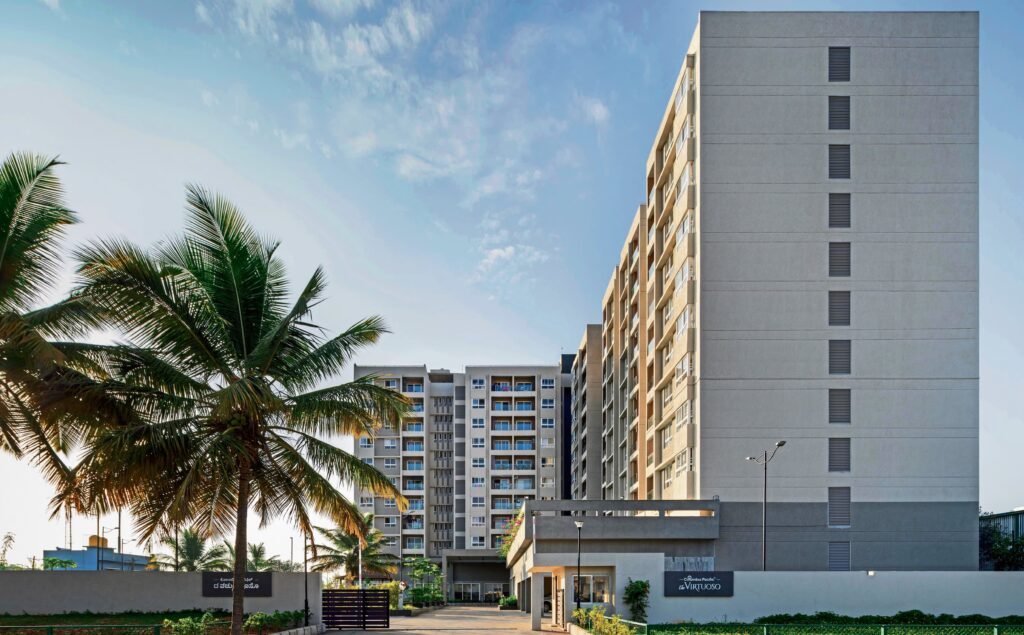Uncover the increasing trend of NRIs investing in exclusive residential assets including lavish flats, land parcels, opulent villas, and residences within retirement communities. Gain insight into the factors stimulating NRI involvement in the thriving luxury real estate marketplace.
Resurgent Interest in Indian Real Estate Market Among NRIs
In a heartening reversal of fortunes, the Indian real estate market has witnessed a renewed surge of interest from Non-Resident Indians (NRIs) alongside investors after a prolonged lull. The pandemic-induced restrictions, particularly for NRIs who were unable to visit their families in India, has played a significant role in reigniting their interest in the real estate sector.
Past Challenges and Current Opportunities
The backdrop to this resurgence is marked by a history of bitter experiences faced by NRIs and investors in the Indian property market. Snigdha Basu and her husband, who had previously faced setbacks with an incomplete project by Unitech Ltd, found themselves reconsidering their stance after several years of shunning the Indian property market. Driven by the increasing demand for properties close to possession, they recently made a successful investment in a 3BHK condominium in Picnic Garden, South Kolkata. This positive experience has prompted her cousin and brother to embark on their own property search, signaling a promising revival in the real estate sector.
Targeted Investments and Positive Market Indicators
Furthermore, the recent upswing in property prices has presented an opportune moment for discerning investors to make strategic investments, a sentiment echoed by Ms. Basu, a seasoned banking professional. Her cousin, Chandrima Chowdhury, seized a similar opportunity by booking an apartment in a project that is scheduled for completion in a year. These instances underscore a growing trend of targeted investments in properties nearing completion, signifying a shift in the market conditions.
Diverse Investor Profiles and Global Reach
The resurgence in the real estate sector has not only enticed NRIs, but also piqued the interest of global investors from diverse backgrounds. Executives from corporate and finance sectors, medical professionals, entrepreneurs, and technocrats from West Asia, South-East Asia, the US, the UK, Europe, and even business families from Africa have been actively engaging in the Indian real estate market. This multifaceted influx of investments spans across premium apartments, plots, villas, and homes in retirement communities, indicating a buoyant market sentiment.
This resurgence not only reflects the evolving dynamics of the Indian real estate sector but also serves as a testament to the growing confidence and interest among NRIs and global investors in the market’s potential for fruitful investments.
Increasing NRI Participation in Indian Real Estate Market
Recent estimates from proptech firm NoBroker reveal a notable rise in the share of Non-Resident Indians (NRIs) in the Indian real estate market. The NRI contribution to annual home sales, which remained below 10% prior to 2020, surged to 15% in 2023. Analysts project a further increase to 20% by the year 2025. This growth signifies a significant shift in the market dynamics, as NRI investors display renewed confidence in the residential segment.
Revival of Investor Confidence
Notably, the residential market has experienced a surge in activity, leading to an upward trend in home prices. Investors are making a strong comeback, particularly in the National Capital Region (NCR). This resurgence in investor sentiment marks the re-engagement of a more discerning NRI investor base. Shveta Jain, the Managing Director of Residential Services at property advisory firm Savills India, emphasizes the current uptick in NRI participation.
Focus on Cautious Investment
Reflecting on previous investment setbacks, NRIs are adopting a cautious approach and directing their investments towards developers with a proven track record. These developers have demonstrated a commitment to timely project delivery and upheld their promises to buyers. According to Jain, NRIs are targeting developers whose projects are poised for substantial capital appreciation. For NRI investors, the primary objective remains a secure investment with the potential for capital growth, given the prevailing low rental yields.
This resurgence in NRI participation emphasizes the evolving landscape of the Indian real estate market. As NRIs strategically navigate their investment choices, developers with a reliable reputation for project delivery and performance are likely to draw increased interest from this discerning investor segment.
Capitalizing on NRI investors: DLF’s Success Story

In the real estate market, DLF Ltd, the country’s largest developer, has made significant strides in attracting Non-Resident Indian (NRI) investors to its various luxury projects. The developer’s latest project, ‘Privana South’ in Gurugram, saw a remarkable 25% share held by NRI investors from different countries, signifying a strategic shift in investor engagement.
NRI Investment Surge
The surge in NRI interest in DLF’s projects is attributed to the developer’s proactive NRI outreach program, which actively engages with investors, conducts meetings, and ensures real-time support. Aakash Ohri, joint managing director and chief business officer at DLF Home Developers Ltd, highlighted the importance of trust in DLF, improved connectivity and infrastructure, and competitive pricing as key factors driving NRI interest in their recent projects.
Strategic Engagement and Trust
DLF’s efforts to secure specific inventory for NRI investors and synchronize project launches in India and overseas have played a pivotal role in attracting NRI interest. This approach provides NRI investors with access to premier inventory and real-time information updates, enhancing their overall investment experience.
Market Dynamics
The resurgence of NRI interest in property investments in the NCR region, particularly in Gurugram, is significant. While faster capital appreciation in these markets is a driving factor, the increased demand for under-construction projects offering cost arbitrage signals a broader reengagement of investors in the market.
Future Prospects
The success of DLF in attracting NRI investors to its upscale projects reflects a changing landscape where strategic investor engagement, trust, and infrastructure development play integral roles. As the market continues to evolve, developers are capitalizing on the NRI investor segment through proactive strategies and enhanced customer support. This trend signifies a promising window of opportunity for both developers and NRI investors in the Indian real estate market.
Increased NRI Interest Across Regions
Growing Interest in Mumbai’s Real Estate
Echoing this trend, Mumbai’s K Raheja Corp Homes has noted heightened interest from NRI buyers hailing from Dubai and Kuwait, with Hyderabad and Pune emerging as the top destinations of choice. This upswing in NRI interest underscores the increasingly global nature of real estate investment and the broader appeal of Indian property markets.
Investment Profile of NRIs
It is noteworthy that like their domestic counterparts, NRI investors demonstrate diverse investment horizons, encompassing both short and long-term perspectives. Consultants emphasize that the current influx of investors possesses the financial capacity for long-term holdings, a trend indicative of sustained confidence in the market.
Outlook on Prices and Preferences
Prashant Thakur, director and research head at Anarock Group, highlights that while property prices are witnessing growth, such increases remain rational. Rental yields are also on the rise. NRIs predominantly purchase properties for personal use or for rental purposes, often driven by an emotional connection to their homeland. This creates a close-knit community effect, whereby joint investments or subsequent purchases are influenced by their peers’ decisions.
The Growing Interest of NRIs in Infrastructure-Linked Real Estate Projects

The increasing interest of Non-Resident Indians (NRIs) in real estate investments has been marked by a surge in sales and inquiries, fueled by a combination of emotional and practical factors. Notably, the recent consecration of the Ram temple in Ayodhya, Uttar Pradesh, has sparked enthusiasm among NRIs, with Mumbai-based developer House of Abhinandan Lodha witnessing a significant influx of NRI interest in its project, ‘The Sarayu’. The unprecedented response saw the entire inventory of 250 plots, priced at ₹1.72 crore onwards, being sold out within 24 hours, with around 33% of the participation coming from NRIs.
Emotional Connection and Practical Considerations
The emotional affinity towards the temple town has undoubtedly influenced the surge in NRI interest, but there are also practical considerations at play. It is evident that NRIs are not only driven by an emotional connection to the sacred site but are also keenly observing the large-scale infrastructure developments in the region, which are expected to drive real estate prices upward.
Abhinandan Lodha, the chairman of House of Abhinandan Lodha, noted that the participation of NRIs has significantly intensified over the past few years. This stands as a testament to NRIs taking a long-term view, particularly with the future in mind for the next generation. The company’s proactive approach in establishing a global distribution network has spurred interest from NRIs across 63 countries, emphasizing the universal appeal of real estate investments.
Infrastructure-Driven Investments
In addition to the Ayodhya project, NRI interest has been robust in other large-scale infrastructure-linked ventures such as a project in Goa and premium villas in Alibaug. NRIs have been notably responsive to initiatives that enhance connectivity and augment the value of real estate in the surrounding areas.
The recently inaugurated Mumbai Trans Harbour Link (MTHL), also known as the ‘Atal Setu’, has generated expectations of heightened real estate activity in Navi Mumbai. Moreover, the imminent completion of the Navi Mumbai International Airport by the year’s end further reinforces the attractiveness of the area for potential real estate investments. This has led to a surge in NRI investor inquiries, particularly in Panvel, where significant infrastructure developments are shaping the city’s future as a desirable destination.
Navin Makhija, the managing director of Wadhwa Group, highlighted the substantial increase in NRI investor interest, with a particular focus on Panvel, the location of their ‘Wadhwa Wise City’ project. The completion of long-awaited projects such as the MTHL and the upcoming international airport has bolstered confidence among investors, positioning Panvel as a promising future destination for real estate investments.
Diversifying Investments: NRIs and Fractional Commercial Real Estate Platforms
Shifting Focus
Historically, Non-Resident Indian (NRI) investors have predominantly concentrated on residential real estate projects. However, there is a notable trend of diversification as NRIs are increasingly exploring fractional investment platforms in commercial assets. These platforms enable investors to own a portion of commercial properties such as offices, warehouses, and luxury holiday homes.
Fractional Ownership Platforms
One such platform, Strata, has been operational for four years and holds a diverse NRI client base spanning various countries including Dubai, Japan, Kenya, the US, and the UK. A significant 25% of its assets under management (AUM) amounting to ₹1,300 crore is attributed to NRI investors. According to Nihar Shah, the director and head of investments at Strata, these platforms offer pre-investment transparency, digitized transactions, and attractive returns, thereby establishing fractional investment as a crucial asset class.
Attractive Returns and Regulatory Impact
The prevailing residential yields in India have been relatively low, ranging between 2-3%. In contrast, commercial office spaces boast higher yields averaging between 7-9%. Furthermore, fractional real estate ownership platforms, such as Strata, present an even more attractive prospect with a targeted internal rate of return (IRR) of 13-15%, comprising both rental yield and capital appreciation.
With expectations of the Securities and Exchange Board of India (SEBI) bringing these platforms under its jurisdiction, both retail investors and NRIs are anticipated to gain confidence, potentially leading to increased participation. As SEBI is likely to consider reducing the minimum investment from ₹25 lakh to ₹10 lakh, it is predicted that NRI participation will witness substantial growth within the next three to five years. According to Nihar Shah, Strata’s AUM is projected to reach ₹2,000 crore by March-end, emphasizing the expected growth and new asset acquisitions.
Strong NRI Commitments and Digital Outreach
hBits, another platform raising a ₹500 crore fund for commercial real estate investment, has observed robust commitments from NRIs. Shiv Parekh, founder and CEO of hBits, highlights their digital outreach strategy, utilizing digital marketing, wealth managers, financial advisors, and property brokers to engage NRIs. Transactions, including online project walkthroughs and payments, are facilitated digitally, contributing to a seamless investment experience for NRIs.
In conclusion, the emergence of fractional commercial real estate platforms has presented NRIs with diversified investment opportunities, steering away from traditional residential projects. As SEBI’s potential regulation and subsequent reduction in minimum investment threshold are anticipated, it is poised to further catalyze NRI participation and bolster the growth of the commercial real estate investment sector.
The Emotional Connection of NRIs with Indian Real Estate

Columbia Pacific Communities’ The Virtuoso project in Bengaluru has attracted a diverse group of NRI investors. These investors include corporate and finance executives, doctors, entrepreneurs, and tech professionals from West Asia, Southeast Asia, the US, the UK, Europe, and even business families from Africa. The appeal of premium homes across India has captured the interest of these NRIs, reflecting a meaningful emotional connection with their roots.
Senior Living Projects: A New Avenue for NRI Investment
The interest from NRIs extends beyond traditional real estate investments, with a remarkable surge in interest observed in senior living projects, particularly during and since the pandemic. Morley Muralidhar, a 73-year-old individual who has spent 40 years in Raleigh, North Carolina, recently purchased a three-bedroom apartment in Columbia Pacific Communities’ retirement living project, ‘The Virtuoso’, in Bengaluru. This move is indicative of a growing trend among NRIs who are seeking to return to India and realign with their cultural heritage.
Muralidhar’s decision to sell two previously owned apartments in Bengaluru symbolizes the shift in priorities, driven in part by the challenges associated with high maintenance costs and management complexities. He said, “We have strong connections to India. Although we still have jobs, we want to spend more time in India annually.”
Target Groups and Expansion Plans
V. Sivakumar, director of Columbia Pacific Communities, delineates that there are two primary target groups among NRI investors. The first comprises individuals who have spent significant time working overseas and now seek to return to India. The second group consists of those who are eager to partake in India’s remarkable growth story. In response to the burgeoning NRI interest, the company is strategically planning expansion into Pune and Kerala, regions that have piqued significant investor interest.
NRI Preferences and Investment Patterns
An insightful survey conducted by NoBroker in November highlighted that the majority of NRI property buyers originated from the UAE and the US. Notably, 37% of these buyers are professionals in the IT/technology sector. Bengaluru emerged as a prime choice for property investment, garnering interest from approximately 29% of NRIs.
The exceptional capital appreciation witnessed in the real estate market over the past year has enticed NRIs, prompting a heightened interest in property investments. Saurabh Garg, co-founder and chief business officer of NoBroker, stated, “Around 60% of NRIs are purchasing properties valued at ₹80 lakh and above. Furthermore, approximately 40% are acquiring properties for investment purposes, while 60% are making purchases for their families in India or for future plans.” The shift in the investment landscape reflects a newfound confidence among NRIs, who are seizing the opportunity presented by evolving property prices.
The profound emotional connection that NRIs maintain with India is becoming increasingly evident through their investment choices, shaping a dynamic and evolving narrative in the real estate market.
Rejuvenation of NRI Investment in Gurugram Real Estate: Speculation or Opportunity?
The real estate market in NCR’s Gurugram has witnessed a resurgence in investor interest, including Non-Resident Indians (NRIs). However, this upsurge has raised concerns about the return of speculators. An analyst inquired during DLF’s earnings call in January about investors in the ‘Arbour’ project seeking to sell their apartments shortly after its launch, leading to an increase in secondary sales prices. Responding to this concern, Ohri indicated that 5-10% of the project’s stock is traded annually, a proportion not deemed alarming.
The existing market conditions have created a window for short-term profit-making. Investors who buy at the pre-launch stage anticipate a rise in prices over a few quarters, with the intention of making a lucrative exit.
On the other hand, Amit Bhagat, MD and CEO of ASK Property Fund, argued that the current market is not conducive for investors due to a 5% GST levy on under-construction projects, coupled with stamp duty. This scenario, he noted, tends to attract end-users, except for plotted projects.
Despite the challenges, the scarcity of inventory in markets such as Gurugram and Noida has reignited the interest of long-term investors, particularly NRIs, due to the fear of missing out.
The crucial question arises: Can these investors achieve substantial compound returns? Initial indications point toward a positive outlook, with the demand continuing to exhibit resilience.
Conclusion
The increased investor activity in the Gurugram real estate market, including the notable engagement of NRIs, raises questions about speculation versus long-term investment opportunities. While some concerns regarding speculative activities have surfaced, the overall market outlook appears promising, with sustained demand bolstering the potential for beneficial returns for investors, particularly for those adopting a long-term investment strategy.











